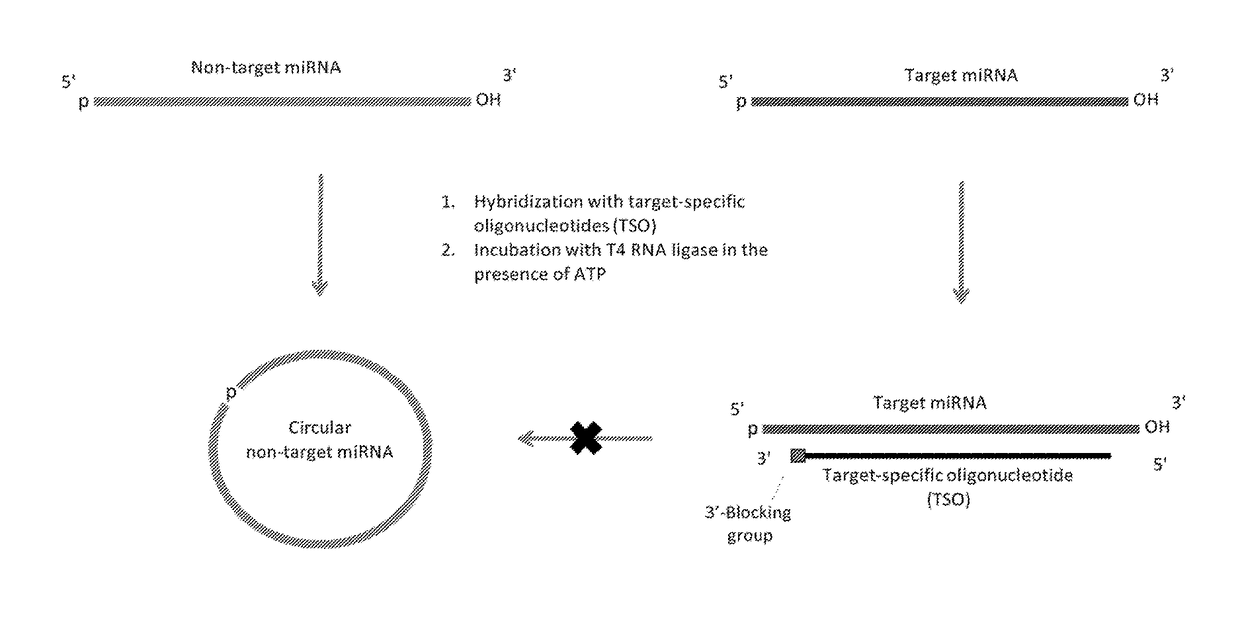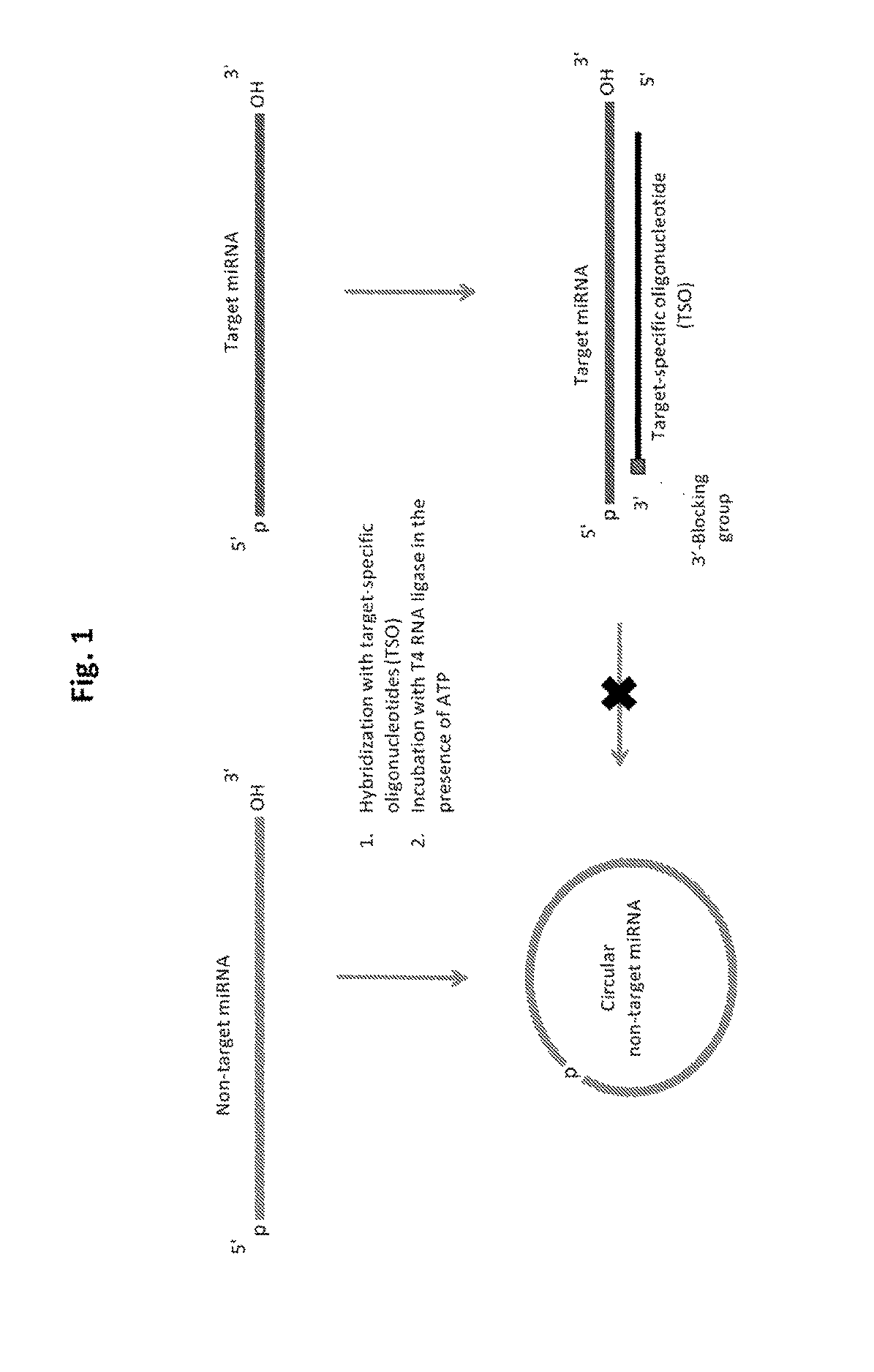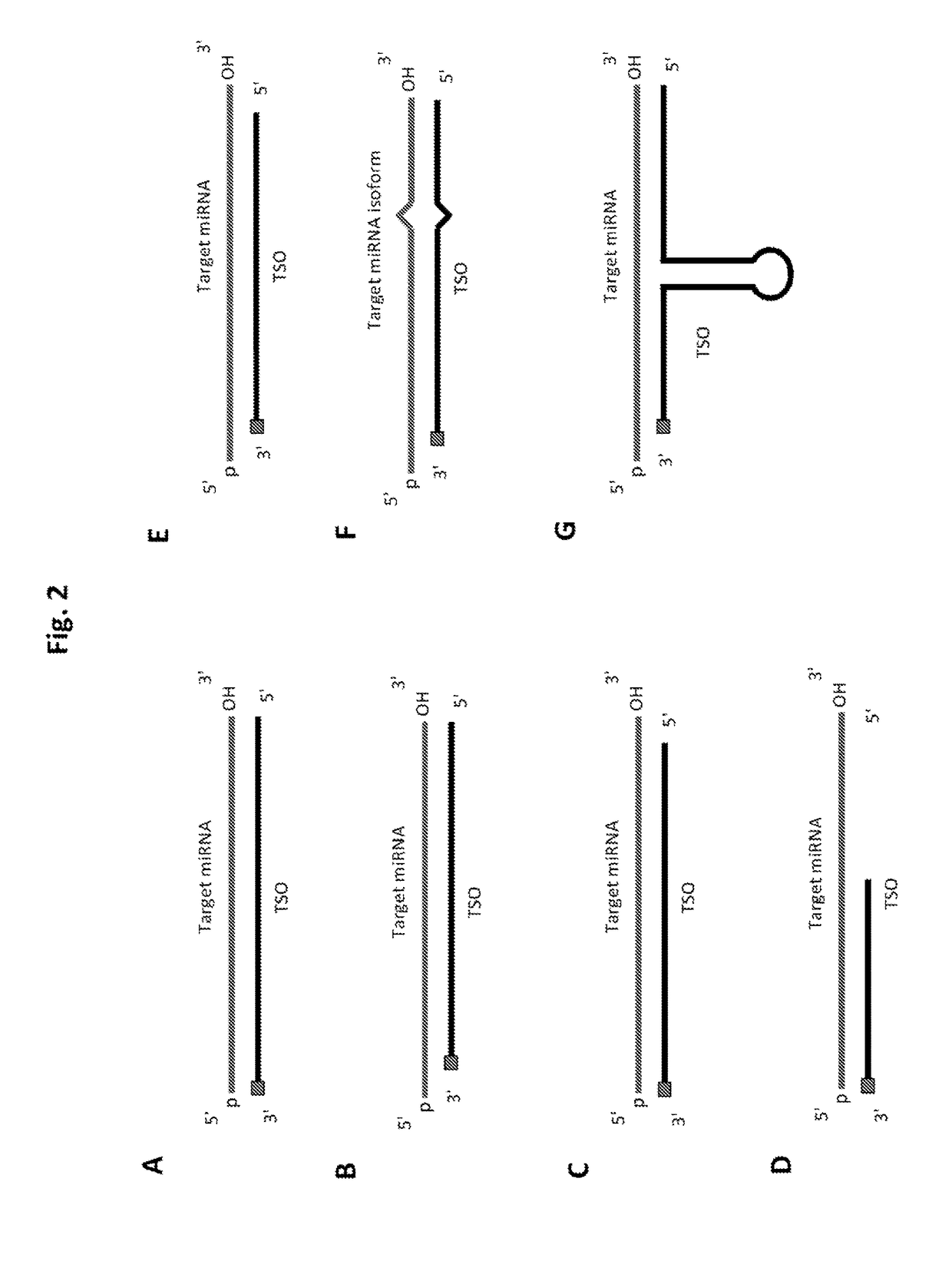Methods of constructing small RNA libraries and their use for expression profiling of target RNAs
a technology of target rna and expression profiling, which is applied in the field of molecular diagnostics, can solve the problems of unsuitable routine mirna expression profiling and diagnostic assays, unparallel sequence specificity, and current ngs methods that are not selective for specific mirna sequences of interest, so as to reduce sequence-dependent bias in adapter ligation, reduce major sources of reaction bias, and reduce the effect of major source of reaction bias
- Summary
- Abstract
- Description
- Claims
- Application Information
AI Technical Summary
Benefits of technology
Problems solved by technology
Method used
Image
Examples
example 1
Design miRNA-Specific Probes
[0240]63 human (hsa-) miRNAs (Table 1) were selected for designing target-specific oligonucleotides (TSO) probes. These miRNAs are listed in Table 1 and labeled according to the efficiency of detection by Solexa sequencing (Hafner et al. 2011), with bold miRNAs undercounted by factors of 0.001-0.005, italic miRNAs undercounted by factors of 0.01-0.09, and plain font miRNAs undercounted by factors of 0.1-0.6 relative to miRNAs that gave the highest read frequency from an equimolar pool of 770 miRNAs.
[0241]
TABLE 1let-7alet-7blet-7clet-7dlet-7elet-7gmiR-634miR-16miR-23amiR-23bmiR-26amiR-30cmiR-31miR-140-5pmiR-34bmiR-92amiR-92bmiR-96miR-99amiR-100miR-199a-3pmiR-103miR-107miR-149miR-125bmiR-182miR-141miR-125a-3pmiR-143miR-145miR-195miR-181bmiR-222miR-182*miR-296-5pmiR-183miR-184miR-210miR-197miR-375miR-199a-5pmiR-486-5pmiR-202miR-205miR-370miR-221miR-766miR-296-3pmiR-885-5pmiR-622miR-328miR-498miR-373miR-640miR-485-3pmiR-574-3pmiR-877miR-497miR-636miR-503miR-8...
example 2
“Solid-Phase Capture” of miRNAs by the TSO Probes
[0243]For this purpose, miRNAs of the miRXplore Universal Reference pool (Miltenyi Biotec) containing equimolar amounts of 954 synthetic miRNAs, including the 63 miRNAs from Example 1, are 5′-32P-labeled by polynucleotide kinase, and then used for multiplex hybridization with a molar excess of the TSO probes. TSO probes specific to the selected miRNAs of a given overhang length (when hybridized to their cognate miRNAs) are pooled, and each TSO pool is hybridized to the miRNA pool. Streptavidin-coated magnetic beads are added to the tube and a magnetic rack (NEB) is used to capture the target miRNAs hybridized to the biotinylated TSOs. The captured miRNAs are washed under conditions providing stability to the immobilized hybrids while allowing all unrelated miRNA species to be washed away (such as at 25° C. by buffer containing 100 mM NaCl, 1 mM EDTA, 40 mM Tris-HCl, pH7.5). The captured miRNAs are then released into solution by heatin...
example 3
Ligation of Adapters in Solution
[0244]In this example, 3′-adapters comprising SEQ ID NO:1 (pUCGUAUGCCGUCUUCUGCUUGUidT (5′-phosphate form)), or (AppUCGUAUGCCGUCUUCUGCUUGUidT (5′-adenylated form)), where idT is inverted deoxythymidine used to block the 3′-end), are used together with the 5′-adapter comprising SEQ ID NO:2 (GUUCAGAGUUCUACAGUCCGACGAUC). These standard adapters, commercially available from the Illumina Small RNA Sample Prep protocol (v.1.5), are sequentially ligated in solution to 32P-labeled miRNAs (from Example 2) that are either free or pre-hybridized to the TSOs. These ligation reactions are performed in the presence or absence of ATP for the 5′-phosphate or 5′-adenylated forms of the 3′-adapter, respectively. For 3′-adapter ligation, the following RNA ligases can be used: Rnl1, Rnl2(1-249), or Rnl2(1-249)K227Q (NEB). These ligases can be used individually or in all pairs of two ligases as a possible approach to balancing out their biases. Rnl1 is used for 5′-adapter ...
PUM
| Property | Measurement | Unit |
|---|---|---|
| temperature | aaaaa | aaaaa |
| volume | aaaaa | aaaaa |
| total volume | aaaaa | aaaaa |
Abstract
Description
Claims
Application Information
 Login to View More
Login to View More - R&D
- Intellectual Property
- Life Sciences
- Materials
- Tech Scout
- Unparalleled Data Quality
- Higher Quality Content
- 60% Fewer Hallucinations
Browse by: Latest US Patents, China's latest patents, Technical Efficacy Thesaurus, Application Domain, Technology Topic, Popular Technical Reports.
© 2025 PatSnap. All rights reserved.Legal|Privacy policy|Modern Slavery Act Transparency Statement|Sitemap|About US| Contact US: help@patsnap.com



